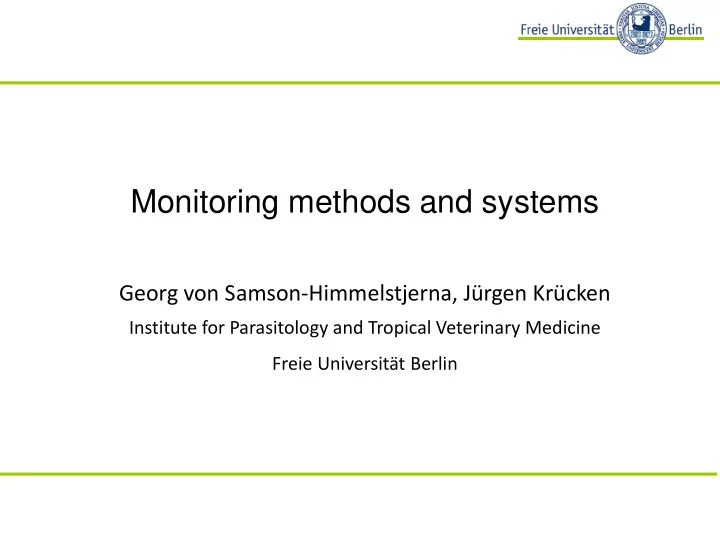

Monitoring methods and systems Georg von Samson-Himmelstjerna, Jürgen Krücken Institute for Parasitology and Tropical Veterinary Medicine Freie Universität Berlin
What suitable and validated tools/tests are currently available for monitoring resistance for all relevant species? Where are the problem areas? Which monitoring systems for anthelmintic resistance are available or needed in Europe?
What suitable and validated tools/tests are currently available for monitoring resistance for all relevant species? Non (maybe one) Where are the problem areas? Everywhere (in principle) Which monitoring systems for anthelmintic resistance are available or needed in Europe? Non (available)/basic routine efficacy screens (needed)
Detection of AR in vivo assay: • Worm count based efficacy tests (controlled test) Compare worm counts in treated versus un-treated animals post necropsy • Faceal-Egg-Count-Reduction test (FECRT) Compare faecal egg count before and after treatment. in vitro assays: • Egg-hatch inhibition test Compare number of hatched larvae in presence and absence of different anthelmintic concentrations • Larval-development inhibition test Compare number of larvae which underwent development to third stage in presence and absence of anthelmintic •Larval-migration inhibition assay Compare number of larvae which migrated through a sieve following incubation in presence and absence of anthelmintic • Allele specific molecular tools (PCR, Pyrosequencing) Qualitative and quantitative assays for the detection benzimidazole resistance
What suitable and validated tools/tests are currently available for monitoring resistance for all relevant species? in vivo assay: • Worm count based efficacy tests (controlled test) Compare worm counts in treated versus un-treated animals post necropsy Technically suitable for ALL gastro-intestinal nematode and tapeworms species, lungworms, fluke and ALL drug classes NOT available for monitoring due to requirement for necropsy of hosts
What suitable and validated tools/tests are currently available for monitoring resistance for all relevant species? in vivo assay: • Faceal-Egg-Count-Reduction test (FECRT) Compare faecal egg count before and after treatment. Technically suitable for MOST gastro-intestinal nematode and tapeworms species, fluke (not for lungworms) and ALL drug classes Not available for monitoring simply due to high costs
What suitable and validated tools/tests are currently available for monitoring resistance for all relevant species? in vitro assays: • Egg-hatch inhibition test Compare number of hatched larvae in presence and absence of different anthelmintic concentrations Technically suitable for ruminant and equine gastro-intestinal strongylid nematode species and benzimidazoles Available for monitoring
What suitable and validated tools/tests are currently available for monitoring resistance for all relevant species? in vitro assays: • Larval-development inhibition test Compare number of larvae which underwent development to third stage in presence and absence of anthelmintic Suitable and validated for ruminant gastro-intestinal strongylid nematode species and benzimidazoles, imidazothiazoles/tetrahydropyrimidines, macrocyclic lactones Available for monitoring
What suitable and validated tools/tests are currently available for monitoring resistance for all relevant species? in vitro assays: • Larval-migration inhibition assay Compare number of larvae which migrated through a sieve following incubation in presence and absence of anthelmintic Technically suitable (not fully validated) for ruminant gastro-intestinal strongylid nematode species and imidazothiazoles/tetrahydropyrimidines, macrocyclic lactones Not (yet) available for monitoring
What suitable and validated tools/tests are currently available for monitoring resistance for all relevant species? in vitro assays: • Allele specific molecular tools (PCR, Pyrosequencing) Qualitative and quantitative assays for the detection benzimidazole resistance Technically suitable for some ruminant gastro-intestinal strongylid nematode species and benzimidazoles Available for monitoring
Where are the problem areas? Sheep parasites: • BZ resistance widespread in trichostrongyles, however, only few studies and no spatial prevalence information in most countries • Resistance against flukicides widespread in UK/Ireland but not sufficient prevlance data available there and almost no efficacy data in other countries Cattle parasites: • ML resistance apparently emerging in trichostrongyles and basically no prevalence data available Horse parasites: • BZ and PYR resistance in Cyathostomins widespread but no current prevalence data in most countries • ML resistance in Parascaris spp. occurring on stud farms but no prevalence data available
Which monitoring systems for anthelmintic resistance are available or needed in Europe? Sheep/goat parasites: • GIN: BZ resistance monitoring (possibly pooled flock samples) and using molecular tools (e.g. beta-tubulin codon 167/198/200 pyrosequencing) or • GIN: EHT based BZ resistance monitoring (possibly pooled flock samples) • GIN: FECRT based ML resistance surveillance in ‘hot spot’ regions/countries, elsewhere efficacy screening using post treatment testing • FECRT based flukicide resistance surveillance in ‘hot spot’ regions/countries, elsewhere efficacy screening using p.t. testing
Which monitoring systems for anthelmintic resistance are available or needed in Europe? Cattle parasites: • GIN: FECRT based ML resistance surveillance in ‘hot spot’ regions/countries, elsewhere efficacy screening using post treatment testing
Which monitoring systems for anthelmintic resistance are available or needed in Europe? Horse parasites: • Cyathostomins: FECRT based BZ and PYR resistance prevalence monitoring each 3 rd to 5 th year • Parascaris : FECRT based ML resistance prevalence monitoring on stud farms each 3 rd to 5 th year
Which monitoring systems for anthelmintic resistance are available or needed in Europe? Generally needed: EU reference laboratory/laboratories • Establishment and maintenance of reference strain library • Evaluation/validation of monitoring tools • Training in AR detection/monitoring
Recommend
More recommend